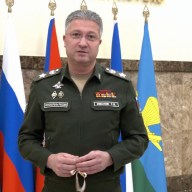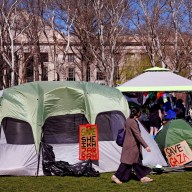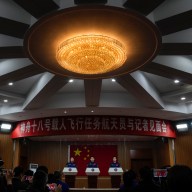 Filmmaker Joshua Oppenheimer spent five years in Indonesia making “The Act of Killing.”
Filmmaker Joshua Oppenheimer spent five years in Indonesia making “The Act of Killing.”
Credit: Getty Images
Born in Austin, Texas, but based in Denmark, Joshua Oppenheimer spent years in Indonesia, where he made a handful of documentaries. He spent five years researching and shooting “The Act of Killing,” which hangs with the members of a former death squad, one comprised of gangsters rounded up to kill Communists — and anyone else they feel like — in the wake of a failed coup. The group wound up murdering at least 500,000 people. They’ve not only never been tried for their crimes but have become celebrities, boasting about their deeds. That made it easier for Oppenheimer to get frank commentary from them, even if he used the film to get them to confront their acts through splashy reenactments of their murders.
You can stream the film below. We talked to Oppenheimer about the reaction to the film.
Having killed at least 1,000 people on his own, Anwar Congo is the one in the film who becomes the most remorseful about what he did. What were his reactions to seeing the finished film?
He was silent for a long time. You can’t simply watch a film like this if you’re the main character. He was very emotional, he was tearful. He went to the bathroom, pulled himself together and came back. And he said, “Josh, this film shows what it’s like to be me.” He said he was relieved to be able to show what these events mean — not just what he did but what they mean. From that point on Anwar and I have remained in touch every few weeks.
At first I wanted to remain in touch to make sure he was safe. I was particularly concerned [Pemuda Pancasilla, the right-wing paramilitary organization he helped found] might scapegoat him for making the organization look bad. They haven’t done that. I see that risk passing. We’re both trying to do something much bigger than the film. He was trying to run away from it and deal with a lifetime of pain, and I was trying to expose a regime of impunity on behalf of the survivors.
What about some of the other subjects?
If you watch the director’s cut, you see Herman [Koto] become more and more angry as the film reaches its conclusion. He pays a bigger role in the longer cut. You see him become disillusioned with being used (by Pemuda Pancasilla). He’s one of the few people brave enough to hold screenings of the film in the city of Madiun, where we made it.
How difficult was it to get it screened in Indonesia?
Our whole strategy for releasing the film in Indonesia was to avoid it being banned. We know the moment the film is banned it becomes a crime to show the film at all. To avoid that we had to build up a pretty high level of cultural, political and media support before we started screening at all. Throughout the autumn of 2012 we screened the longer cut of the film at the National Human Rights Commission in Jakarta. Everyone said this film must be seen. We encouraged them to hold screenings in their local communities. From there it grew exponentially. By the summer there were well over 1,100 screenings in 118 cities — that we know of. People would often hold repeat screenings without telling us. Starting six months ago every screening was public.
The editor of the largest and most venerable news publication in Indonesia told me, “There was a time before ‘The Act of Killing’ and now there’s a time after ‘The Act of Killing.’ I’ve been censoring stories about this genocide ever since it’s been my job, and I’m not going to do it anymore. Your film shows me I don’t want to grow old as a perpetrator.”
What was the reaction once everybody in Indonesia starting seeing it?
The country was astonished at this holocaust that underpins the whole system yet is never discussed. They never thought of it as a holocaust in the mainstream media. Then it was in the most important paper in the country, and that set the tone for the rest of the media to follow suit and break their own silence. It’s like the “Emperor’s New Clothes,” with everyone now pointing out that the king is naked. Everyone knew it but was afraid to say it. But now that it’s been said forcefully by the perpetrators themselves, there’s no denying it and there’s no stuffing the genie back in the bottle.
How did the use of reenactments come about?
They came about organically. After filming perpetrator after perpetrator boasting about what they did, they would invariably say, “I will show you where we did it. I will take you to the places we killed.” I would go with them and they would launch into spontaneous demonstrations of how they killed, and then complain afterwards that they didn’t bring along a machete as a prop or a friend to play a victim. That impulse to reenact demonstrates how, on one hand, the boasting is a way of asserting to themselves that what they did was OK.
Once killers are done they write a story. They tell stories to justify their actions. It’s the victors’ history. They do that because they’re human. They need to maintain that story lest they have to face the reality of what they’ve done and be tormented by guilt for the rest of their lives. To maintain that story inevitably leads to a downward spiral to further evil and corruption, because now you have to blame the victims for what you’ve done to them. It’s much easier to live with yourself if the people you’ve killed are not fully human. The irony here is that the further evil is perpetuated not because Anwar is a monster or an inhuman psychopath who doesn’t care about the human dimensions of what he does. It’s because he’s human, and being human he knows what he’s done is wrong. He’s too afraid to confront that fact, therefore he has to maintain a lie.
The film closes with Anwar retching but not able to actually confess that he’s a murderer.
Anwar doesn’t have the courage to consistently, every day, look in the mirror and put into words the physical reactions he has in the final scene in the film — to say, “What I did was wrong.” What human being would? He has lost his swagger. He no longer boasts about what he did. He’s reluctant to speak to journalists, perhaps because he doesn’t want to be blamed.
It’s easy to be shocked by what the subjects are saying in the film, but through repeated viewings it becomes clear that you don’t want to portray them as mere monsters.
I think the critical thing I’m trying to do in this film is to show evil is human. For us to understand that and therefore to prevent evil in the future, we have to be able to look at the humanity of people who kill. It’s not so we can forgive and forget — by all means no. And not because there shouldn’t be justice — again, by all means no. But you need to be able to look at how human beings to do these things to each other. Despite our protestations that these things may never happen again, they happen again and again and again. It’s simply self-serving reassurance to say these people are monsters and have nothing to do with me. And it’s a reckless attempt to reassure one’s self, because it closes down the possibility of understanding, and it closes down the possibility of prevention.
People have talked in relation to this film about the banality of evil. I think the film explores the humanity of evil. The act of killing is a fundamentally human act. We like to call it inhumane, again to reassure ourselves we would never do it. But human beings are the one species that kills with this kind of gusto on this kind of scale. Yet every time we kill it’s a traumatic act, and we need to distance ourselves from killing.
















